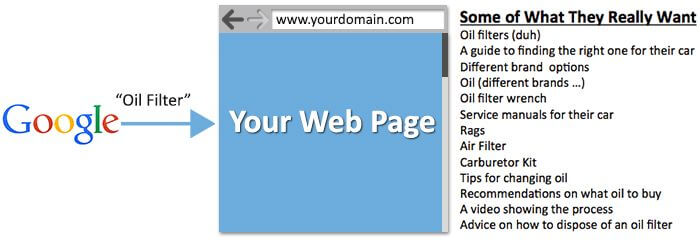How The 100 User Model Can Change Your Approach To On-Page SEO
User experience has become increasingly important as a ranking factor in search, but how can you measure something that's seemingly so subjective? Columnist Eric Enge offers up his method.
During the Periodic Table of SEO Ranking Factors session at SMX Advanced, Cyrus Shepard, Marcus Tober and I talked about how much the search landscape has changed over the years. As part of this discussion, a few key themes emerged:
- On-page SEO is no longer keyword-centric.
- Content quality is truly critical, and this is just as true for e-commerce pages as it is for long-form blog posts.
- User experience is important, and engagement with a page is much broader than just the words on that page.
The precise method that Google might use to measure the factors above is not 100% clear. However, knowledge of the exact mechanics aren’t necessary to map out a plan to build a site that is more SEO friendly, which is what I will focus on in today’s post.
What Makes A Quality User Experience?
There are many factors that contribute to a quality user experience. I am going to offer an illustrative example focusing e-commerce pages, but the concept will apply to other types of pages as well.
Let’s start by imagining that you receive 100 visitors to one of the commerce pages on your site, and they got there after searching on Google for a phrase like “oil filter.” Now, ask yourself a question: What percentage of those people end up being happy with the experience?
We all know that the answer is not 100% — it’s something a lot less than that. After all, no matter how good your page might be, some people will find it irrelevant to their needs and bounce off quickly. One model for what might happen with your page looks like this:
People have many needs when they come to your site, and how satisfied they are depends on how completely you meet those needs. There are many ways in which a page might not meet a visitor’s needs (and thus cause them not to convert), including:
- They may not be ready to buy yet (they may be in research or comparison shopping mode).
- They might not like your site (or find it baffling) and simply leave.
- You might not have the specific product they want.
- Your prices might not be what they are hoping for.
- They might get distracted by something else and abort the visit to your site.
There are many other reasons why they might not have purchased something. However, their not buying anything does not necessarily mean they were disappointed with the visit or that Google will see it as a “bad visit.”
In today’s world, you should treat the percentage of people that are satisfied with their visit to your page — and how that compares with the percent satisfaction people have with pages competing with you in the SERPs — as a ranking factor.
Why Is This Important To Google?
Google operates a business, and they are in it to make money. If Google sends many people to a web page, and 95% of them have a bad experience with that page, it reflects badly on Google, and it will impact usage and revenue.
As backup to that last statement, consider these tests run by Google and Bing. Even small delays in loading their search results have significant impacts in usage and revenue.
I understand that SERP page speed is not a 1-to-1 with the scenario I am outlining above, but it’s not a big leap to imagine that poor quality search results would also impact search engine usage and revenue as well.
Here is an fictitious example of a particularly bad page design:
The problem with this page is that it is optimized completely around one single goal: immediate conversion. Chances are that this page will address the needs less than 5% of users that land on it, and the remaining ~95% will exit the page quickly.
Google can certainly measure when people click on a search result, spend a very short time on the page, and bounce back to the search result (you can call that a “short click”) and then click on another search result and don’t come back (“pogo sticking”). Google can also detect when they spend a long time there before coming back (a “long click”), or when they don’t come back at all.
The search engine can also perform content analysis of the page and detect that it’s very one-dimensional. This alone can signal a page that is less likely to satisfy users sent to it.
Either of these two approaches (or some variant or combination of both of them) can flag that the page offers a very poor experience to the great majority of users. Any such analysis is likely comparative in nature, where the metrics for your page are compared with that of other pages equally relevant to the same query.
Persona Mapping & Page Design
As you start to think about this more, you naturally start to wonder about what it is that the people who arrive on your pages actually want to do. The most basic categories of needs are:
- People just looking for information
- People ready for a transaction
Within each of these two broad categorizations, there are many other needs as well. Here are some of the various types of needs someone in transactional mode may have:
- Product specification. Many e-commerce sites offer ways to sort and filter products. If someone is looking for windshield wipers, they probably will need to specify the year, make, and model of their car.
- Related products. Someone looking for an windshield wipers might also be looking for windshield fluid.
- Additional products. The person looking for windshield wipers might also want to replace their oil filter.
- Signs of trust. This can be as simple as having a privacy policy on the site, or user reviews for products.
Looking back at the potential user needs I showed in my earlier graphic, the percentages might look something like this:
Ask yourself: If a user comes to your page after searching on “oil filters,” should they be able to see a link to your windshield wipers on that same page? It would certainly seem so.
In addition, if you have a site that focuses only on parts related to oil changes, what do you think your chances of ranking for a term like “auto parts” would be? Do you think there is any chance you could get enough links to make that happen? Probably not.
Ultimately, the variety of needs that users might have is usually endless, and you can’t satisfy everyone. Many considerations go into getting this right. For that reason, it’s useful to do lots of testing on the pages of your site and to have an understanding of the types of people who visit it.
This is where the concept of personas comes in. Consider interviewing (or conducting surveys with) hundreds of visitors into your site, with the goal of learning about them and what they are looking for.
With this, you could start to look at these people and categorize them into various buckets. If someone tells you that they were looking for product reviews, you have an example of a person in research mode.
But the informational/transactional distinction is not all you should be looking for. Persona mapping can dive into many different areas, such as (still using an auto parts site as my example):
- Age
- Gender
- Income
- Do they work on the car by themselves?
- Type of car they drive
- What motivates them?
- What are their key goals?
It’s beyond the scope of this article to go into persona mapping in detail, but the concept is an important one.
If you are not familiar with what personas are, or want more information on the topic, here are a couple of articles to get you started:
Summary
Get a handle on what’s taking place on your site, the types of people visiting the site, and then fine tune the site to satisfy a larger percentage of its visitors. We have long known that this will help with conversions on a site.
Traditional aspects of SEO still matter, but the concept of increasing user satisfaction with the pages of your site has become good SEO, too.
You should invest the time and effort to better understand what visitors to your site are looking for. This impacts design for sure, but also your business model, your product offerings, site structure, and ultimately, SEO. If you want to be a winner in SEO in the long term, you are going to have to deliver superior user experiences on your website.
Contributing authors are invited to create content for Search Engine Land and are chosen for their expertise and contribution to the search community. Our contributors work under the oversight of the editorial staff and contributions are checked for quality and relevance to our readers. The opinions they express are their own.
Related stories
New on Search Engine Land



